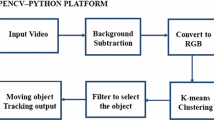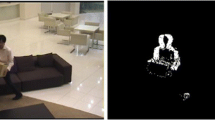Abstract
Connected region detection is usually used to obtain foreground regions from foreground image after moving object detection. In order to remove noise regions and retain true targets, a threshold that limits the circumference of foreground regions should be introduced. The method which uses the same threshold for all surveillance videos cannot handle scene changes. In this case, we propose an adaptive threshold algorithm for moving target segmentation. A strategy based on the combination of background modeling and Grabcut is presented to extract foreground objects and set an initial threshold. On the base of this, we can choose some foreground as samples and classify them by K-means clustering method. Finally, an appropriate threshold could be selected for moving object segmentation according to the classification result. Experimental results show that the proposed method has strong adaptability to various scenes and improves the accuracy oftarget segmentation.
Chapter PDF
Similar content being viewed by others
References
Ding, Y., Wenhui, L.: Robust moving object detection under complex background. Computer Science and Information Systems 7(1), 201–210 (2010)
Chaohui, Z., Xiaohui, D., Shuoyu, X., et al.: An improved moving object detection algorithm based on frame difference and edge detection. In: Fourth International Conference on Image and Graphics, ICIG 2007, pp. 519–523. IEEE (2007)
Castleman, K.R.: Digital Image Processing. Prentice Hall &清华大学出版社 (1998)
Brutzer, S., Hoferlin, B., Heidemann, G.: Evaluation of background subtraction techniques for video surveillance. 2011 IEEE Conference on Computer Vision and Pattern Recognition (CVPR), pp. 1937–1944. IEEE (2011)
Rother, C., Blake, A., Kolmogorov, V.: Grabcut - interactive foreground extraction using iterated graph cuts. Proceedings of ACM SIGGRAPH 23(3), 309–314 (2004)
Liu, Z., Shi, R., Shen, L., et al.: Unsupervised salient object segmentation based on kernel density estimation and two-phase graph cut. IEEE Transactions on Multimedia 14(4), 1275–1289 (2012)
Zhang, L., Kong, H., Chin, C.T., et al.: Cytoplasm segmentation on cervical cell images using graph cut-based approach. Bio-Medical Materials and Engineering 24(1), 1125–1131 (2014)
Zivkovic, Z.: Improved adaptive Gaussian mixture model for background subtraction. In: Proceedings of the 17th International Conference on Pattern Recognition, ICPR 2004, vol. 2, pp. 28–31. IEEE (2004)
Shalev-Shwartz, S., Singer, Y., Srebro, N., et al.: Pegasos: Primal estimated sub-gradient solver for svm. Mathematical Programming 127(1), 3–30 (2011)
Pradhan, B.: A comparative study on the predictive ability of the decision tree, support vector machine and neuro-fuzzy models in landslide susceptibility mapping using GIS. Computers & Geosciences 51, 350–365 (2013)
Lu, B., Wei, S.: One more efficient parallel initialization algorithm of K-means with mapreduce. In: Proceedings of the 4th International Conference on Computer Engineering and Networks, pp. 845–852. Springer International Publishing (2015)
He, K., Wen, F., Sun, J.: K-means hashing: an affinity-preserving quantization method for learning binary compact codes. In: 2013 IEEE Conference on Computer Vision and Pattern Recognition (CVPR), pp. 2938–2945. IEEE (2013)
Author information
Authors and Affiliations
Corresponding author
Editor information
Editors and Affiliations
Rights and permissions
Copyright information
© 2015 Springer-Verlag Berlin Heidelberg
About this paper
Cite this paper
Tian, Y., Wang, D., Lin, R., Chen, Q. (2015). An Adaptive Threshold Algorithm for Moving Object Segmentation. In: Zha, H., Chen, X., Wang, L., Miao, Q. (eds) Computer Vision. CCCV 2015. Communications in Computer and Information Science, vol 546. Springer, Berlin, Heidelberg. https://doi.org/10.1007/978-3-662-48558-3_23
Download citation
DOI: https://doi.org/10.1007/978-3-662-48558-3_23
Published:
Publisher Name: Springer, Berlin, Heidelberg
Print ISBN: 978-3-662-48557-6
Online ISBN: 978-3-662-48558-3
eBook Packages: Computer ScienceComputer Science (R0)





